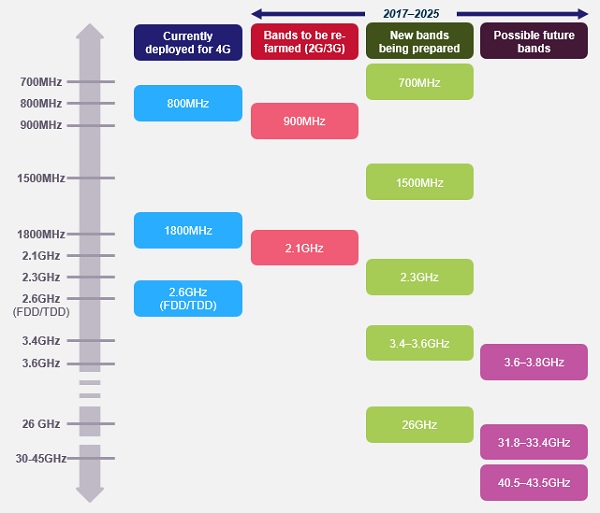5G: The Future of Connectivity
What Exactly is 5G?
5G is the 5th generation mobile networks that will replace telecommunication standards beyond the current 4G levels. 5G is being designed to provide huge capacity and extremely fast data speeds, which will allow the support of new innovations and services. The general, global goals for 5G are: 1000x increase in capacity, support for 100+ billion connections, up to 10GB/s speeds and below 1ms latency (which is very small compared to the 50 milliseconds criteria for 4G) [1]. All of this should result in next to instantaneous browsing/downloading, with negligible/no lag. However, it is worth noting that there are no official specifications for 5G, these global goals are all used very loosely. Having said that, San Marino (a micro-state) is set to become the first country to be upgraded to 5G nationwide, by Telecom Italia [2].
Key Applications to be Serviced by 5G
5G will result in the evolution of existing and new radio technologies. The potential applications can be grouped into 3 main classes. The first is Enhanced Mobile Broadband, which is simply providing faster and more reliable mobile broadband. This will improve the customer experience and allow for even more connected devices. The second is Massive Machine Type Communications, which refers to the Internet of Things (IoT), with gadgets and devices wirelessly connecting to the internet and between themselves. The impact of 5G on IoT will fundamentally change many existing industries and create entirely new industries – such as smart homes, e-health/wearables, environmental monitoring and smart agriculture. However, a lot of consideration will also have to be given to data security and privacy issues, since huge amounts of (personal) data will be transferred over the public realm. The third category is Ultra-Reliable and Low Latency Communications, which is focusing on the reliability and minimal network delays of 5G. Thus making it an appropriate foundation for areas such as vehicle-to-everything communication (e.g. connected/driverless cars), drone delivery, autonomous monitoring and smart manufacturing [3].
The Different 5G Spectrums
5G will incorporate different radio technologies, to serve different purposes. For instance, the lower frequency spectrum (i.e. 700 MHz) will serve wider coverage of places, with thousands of users in a densely populated area. The high frequency spectrum (i.e. 3.4-3.8 GHz) will have the capacity to support a high number of data-intensive devices, with little impact on speed [3]. The new wavelength, which will revolutionise data transmission, is mmWave technology. In other words, the higher the frequency the higher the wavelength – and mmWave represents the highest end of the spectrum, with 30-300 GHz [4]. Due to this higher frequency, it will be able to transmit more data. Although, one issue with this is that high frequency comes paired with shorter transmission ranges. This can lead to issues when there is no direct line of sight from the signal mast to the device, such as walls and buildings being in the way – resulting in potential disruptions to the signal. The graph below shows the spectrum being made available for 5G to come into play within the UK, from Ofcom, the UK government-approved Office of Communications [5].

The Uses of 5G
Mr. John Donovan, the Chief Strategy Officer and Group President of AT&T, referred to 5G as being able to support the most exciting technologies during his time. He stated that AT&T can start implementing 5G as early as 2019, since they need to be ahead of the game. A crucial point was made that for IoT, driverless cars and all of these new devices to be connected, the infrastructure needs to be in place. In this regard, AT&T among other network carriers, play a fundamental role in the future of our interconnected world. Looking at the bigger future, with smart cities operating a unified network for perfect connection, 5G is a good backbone to have. By using shorter wavelengths, we have more spectrum bandwidth available for telecommunications. This can solve the “spectrum crunch” problem, which is resulting in many of the currently available RF bands becoming full. Fortunately, this low transmission range dilemma is not a problem, since the line-of-sight connections between IoT devices/sensors might not be as large [6].
Ultimately, 5G will remove many of the current constraints on connectivity innovation, and allow for creations that may not have been possible using technology available today. Real world testing has already begun, with firms such as AT&T, Intel, Qualcomm, Verizon and Vodafone heavily investing into 5G research [7][8][9]. 5G is definitely an interesting topic worth following, since it will allow networks to handle a massive increase in the number of devices – with a forecasted global rollout around 2020.
References
[1] https://5g.co.uk/guides/4g-versus-5g-what-will-the-next-generation-bring/
[2] https://www.ft.com/content/bdeaec1e-6a17-11e7-bfeb-33fe0c5b7eaa?mhq5j=e1
[3] https://www.ofcom.org.uk/__data/assets/pdf_file/0021/97023/5G-update-08022017.pdf
[5] http://blog.3g4g.co.uk/2017/03/latest-on-5g-spectrum-march-2017.html
[6] http://spectrum.ieee.org/tech-talk/computing/networks/5g-taking-stock
[7] https://9to5mac.com/2016/02/12/5g-att-verizon-testing/
[8] https://newsroom.intel.com/editorials/intel-spotlights-5g-progress/
One comment on “5G: The Future of Connectivity”
Comments are closed.


Hi Jaykishen,
Thank you for this very informational post on 5G. With the rapid growth in IOT technologies, the number of devices that will connect with the internet is predicted to an at least threefold increase. With this new infrastructure, the ability for autonomous driving inches closer to becoming a reality. This poses a question on security for autonomous vehicles. When all of these cars are connected to 5G, a hacker can now use this network to gain access into any and every one of these cars thus leading to catastrophic instances. Car companies are securing their cars through different methods such as encryption, but it is still possible to be bypassed. What are the data service companies doing on their end to ensure the security and safety for these vehicles in order to make autonomous driving a reality?